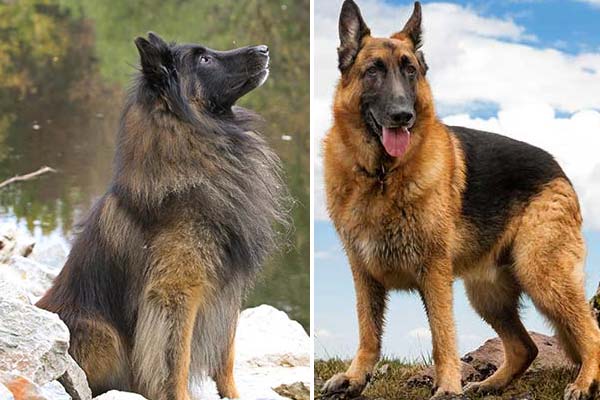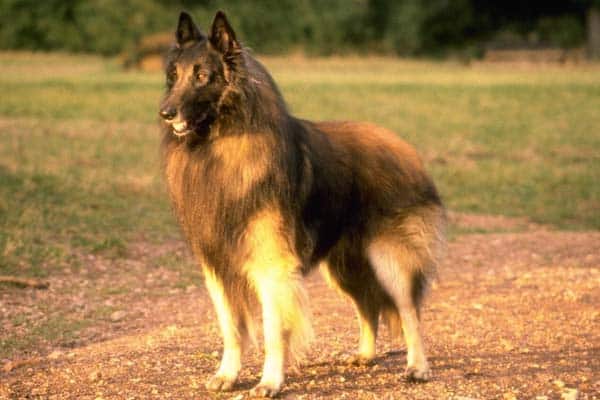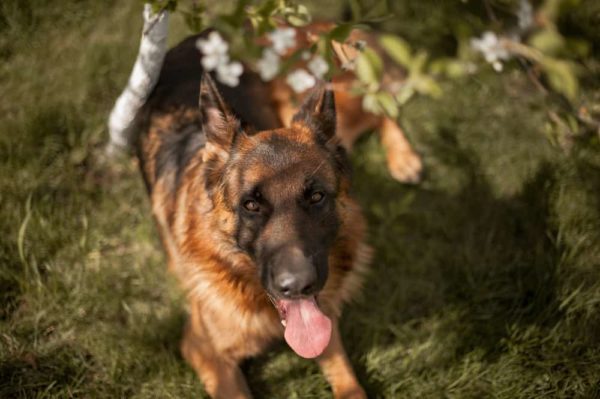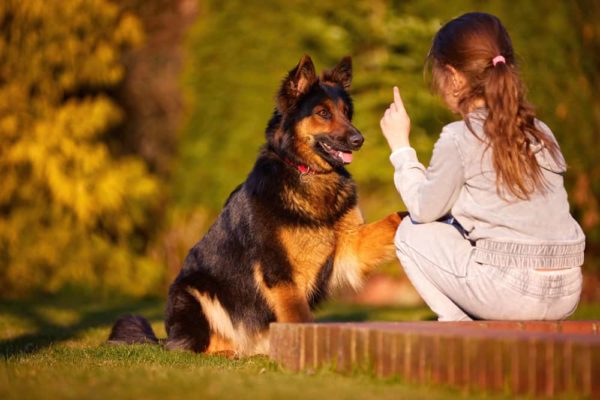18 Differences Between German Shepherds and Belgian Tervurens
At first glance, the German Shepherd Dog (or GSD) and the Belgian Tervuren (or Tervs) look almost identical.
Both breeds have pointed ears, pointed nose, and are roughly the same shape. This is because both breeds were developed to do the same job of herding livestock.
However, there are many differences between the two herding breeds. The German shepherd is far more popular and is prone to certain health problems that rarely, if ever, affect the Terv.
No matter their differences, they are the same in one respect: they both make great pets.
Please keep in mind that the following list is based on generalities of both breeds. In other words, we are comparing the average German Shepherd with the average Belgian Tervuren.
There are individual dogs that do not conform to the norm.

One: Differences in Country of Origin
With a name like the German Shepherd, you’d be forgiven if you thought the breed was from Germany. The breed actually originated in the Alsace region of France.
In Europe and other parts of the world, the breed is known as the Alsatian.
And what about the Belgian Tervuren? They did develop in Belgium. They originated in a specific Belgian town named, oddly enough, Tervuren.
So, unlike the German Shepherd, the name of the Belgian Tervuren does accurately indicate its origins.
Two: Differences in Life Span
Although versatile, intelligent, and incredibly popular dogs, the GSD also has a shorter lifespan than many dog breeds of its size.
According to the American Kennel Club (or AKC), the GSD only lives an average of seven to ten years.
According to AKC, In contrast, the Belgian Tervuren lives an average of twelve to fourteen years. Why is there such an age discrepancy?
This may be due to indiscriminate breeding of the GSD over decades to cash in on its popularity.
Three: Differences in Popularity
If you find a rescue dog you want to adopt that looks like it has GSD or Terv blood in it, chances are that the blood is from a GSD.
This is because the GSD is one of the most popular dog breeds in the world. According to tot eh AKC, it is the second most popular breed in America.
In contrast, the Terv is ranked 106 out of 191 recognized dog breeds in America by the AKC. This makes finding a Terv harder for a person than if you went out to find a GSD.
However, the breed is rising solely but surely in popularity.
Four: Differences in Weight
On the whole, German Shepherds are heavier than Belgian Tervurens. Like in most dog breeds, males of GSDS and Tervs are usually larger and heavier than females. GSDs range in weight from 65 to 90 pounds.
Both breeds measure from 22 to 26 inches high at the shoulder. Dogs are measured from the bottom of their forefeet up to their withers, or tallest point of the shoulder.
Tervs weigh from 45 pounds of a small female to 75 pounds for a large male.
Five: Differences in Breed History
The German Shepherd breed has been around for over 100 years, making him a familiar canine face even to people who aren’t into dogs.
During World War I, American soldiers found out how great the GSD was and brought them home.
In contrast, the Terv is a breed that only came into existence after World War II.
It originally was a variation of the beloved Belgian shepherd, but the variation became so popular that it became its own breed in 1959, according to the American Belgian Tervuren Club.

Six: Differences in Shedding
Although each dog of whatever breed differs in the amount he or she sheds, as a general rule, the German shepherd sheds less overall than the Belgian Tervuren.
Both breeds have a massive hair dump, called “blowing a coat” about twice a year. Both breeds need brushing year-round to get rid of loose or dead hair.
The AKC recommends using a de-shedder comb every day to keep all shedding to a minimum. Brushing helps get rid of loose hair all at once and not bit by bit over time.
The American Belgian Tervuren Club does not recommend Tervurens for anyone who cannot abide shedders or clouds of dog hair.
Seven: Differences in Coat Colors
The GSD comes in a wider variety of coat colors than the Terv. Tervs come in few colors, with the head always darker than the rest of the coat. The coat color can be a silvery grey, tan, or a rich red.
They come in solid black or brown, but these colors disqualify them from the show ring. They also can sport large patches of white, but these are also disqualified from the show ring.
In contrast, the German Shepherd comes in a lot more colors, from solid colors to mixed. Solid colors include black, dark brown (or liver), dark red, all blue (more like a blueish-grey), and all silver-grey.
All whites do crop up but are not considered show worthy.
Bi-colors, or dogs with two colors in their coats, include the most popular color, black and tan. They also come in black and silver, black and red (a rusty red color), black and sable and black and cream.
Tri-colors, or GSDs with three colors, are very rare. They include the panda, which is a lot of white patches on the familiar black and tan or any other bi-color combination.
There are also German shepherd dogs that sport black, tan, and silver in their coats.
Eight: Differences in Coat Lengths
According to the AKC breed standard for the German Shepherd dog, the “ideal” coat length is medium. This means it’s sort of long, but not as long as an Irish retriever’s coat.
However, some GSDs are born with very short coats and some are born with very long coats.
In contrast, most Tervurens are born with long coats. These coats are fluffier in appearance than that of the average GSD’s coat.
The ideal coat hairs are all straight, but some dogs are born with wavy or even curly hair.
Both breeds are born with double coats or two layers of coats. The undercoat, or the coat next to the skin, is softer and finer. The outer coat is harsher so it can better protect the dog from the elements.
Nine: Differences in Eye Colors
The average German Shepherd dog and the average Belgian Tervuren will have the same eye color – a dark, chocolate brown.
However, the GSD breed standard allows for more eye colors than that of the Terv breed standard.
There are pure-blood Tervs born with light brown, tan, or even (gasp) blue eyes. However, these are usually disqualified from the show ring and so are not usually bred.
In contrast, GSDs are allowed any eye color, including blue, but dark eyes are much preferred, especially in the show ring. The breed standard even states that the color “is as dark as possible.”

Ten: Differences in Developing Pannus
Pannus is known by many names such as chronic superficial keratitis, Keratitis Ueberreiter, or its common name of German Shepherd keratitis.
This shows you right away the dog breed most prone to developing it. The second most common breed to get it is the Terv.
However, all dog breeds and mongrels can develop this eye condition that can cause blindness, but they have a far less chance of doing to than a GSD. Why is this?
No one knows for sure but it the theory is that it is a genetic condition, notes VCA Animal Hospitals.
Pannus starts off as a red or pink blob right on the dog’s cornea. The dog’s inner or third eyelid swells, making it appear that pink skin is hanging over the eye. If left untreated, the dog will go blind.
Eleven: Differences in Developing Pancreatic Enzyme Insufficiency
The pancreas does important jobs in extracting nutrients from food. If a dog’s pancreas cannot do this job then a dog could stare to death from malnutrition, no matter how much he or she eats.
This is the sad fate of dogs suffering from malabsorption or pancreatic enzyme insufficiency.
Almost all dogs that get this are German Shepherds, notes the Mid-Atlantic German Shepherd Rescue. The condition is incurable.
Although the condition is treatable, treatments are so expensive that owners often choose to put their dogs down rather than let them suffer.
Twelve: Differences in Getting Von Willebrand’s Disease
German Shepherds lose in the genetic lottery when it comes to a potentially deadly bleeding disorder called Von Willebrand’s disease.
Although more common in breeds like the German shorthaired pointer and poodles, it does appear in GSDs.
Von Willebrand’s disease rarely appears in Belgian Tervurens.
There is a genetic test that can be done to see if a dog is a carrier of the genes that cause Von Willebrand’s, even if the dog shows no symptoms. Dogs with the carrier genes should never be bred.
Dogs suffering from Von Willebrand’s can easily bleed to death at the slightest injury. Their blood lacks the ability to clot like in healthy dogs. There are three types, and all can be tested genetically.
Thirteen: Differences in Susceptibility to Perianal Fistulas
Dogs of all breeds can develop perianal fistulas or PF. These are small holes around the anus that turn into constantly draining sores. The bad news is PF is as painful as it sounds.
The good news is that it is treatable.
As you may have guessed, the dog breed most likely to develop PF is the German Shepherd, notes the Mid-Atlantic German Shepherd Rescue.
Just why GSDs are prone to getting PF is unknown since the cause of PF is unknown.

Fourteen: Differences in Neck Hair
German Shepherd neck hair generally hugs the neck or sticks out very little. Even in longhaired GSDs, the neck hair is nowhere near as ostentatious as the hair surrounding the neck of a Belgian Tervuren.
This neck hair is seen best in males than in females. It sticks out like a fluffy collar. Not all Tervs sport this collar, but it is considered a highly desirable feature for show dogs.
They are also allowed very long hair down the forelegs, which is called “Ornamentation” in the breed standard.
Fifteen: Differences in Hind Legs
The average German Shepherd in North America will have oddly-shaped hind legs. These legs never seem to straighten out, making the dog always appear as if the dog is caught in the act of laying down.
This trait became a fad to GSD breeders and showers in America about the 1980s. It makes the dog look more wolfish, according to its adherents.
This is rarely seen or seen in very moderate forms elsewhere in the world.
The Terv does not have such exaggerated hind legs. They look like the hind legs of any normal, healthy dog. The breed standard even encourages the breeding of Tervurens that stand squarely on all four feet.
Sixteen: Differences in Energy Levels
One of the reasons that GSDs are so popular is that they are not usually hyperactive dogs. They do not need to go, go, go all the time like with other dog breeds like the Jack Russel or the border collie.
The average GSD is a pretty easy-going dog and makes a good choice for first-time dog owners.
In contrast, the average Terv has a lot of energy that needs burning off.
This is a dog that demands a lot of time and interaction since it was bred to run around all day taking care of and defending herds of sheep. It is not a good choice for first-time dog owners.
Seventeen: Differences in Uses in the Military or Law Enforcement
Generally, the police or the Army will prefer to use German Shepherds or Belgian Malinois than all other dog breeds, including the Terv.
This is not because the Terv or other dog breeds are less intelligent or less trainable. It’s strictly to do with size.
Whenever the military or law enforcement needs to put a suspect on the ground, they need a dog large enough and heavy enough to be intimidating and have the strength to pull or knock over a full-grown adult male human.
Only the GSD and the Belgian Malinois fit this bill.
This does not mean that law enforcement never recruits Tervs. According to the AKC, Tervurens are the preferred police dog in their country of origin, Belgium. They also work in search and rescue teams.
Eighteen: Differences in Appearances in the Media
German Shepherds have been stars of the large and small screens since the days of silent movies. One of the most famous movie stars in the 1920s was Rin Tin Tin.
Their intelligence and trainability make them the go-to dog for many movie and television companies.
GSDs not only act as dogs but also as other animals. Their coats are often dyed so they resemble wolves.
Some long-suffering German Shepherds were stuck in bizarre suits so they could portray giant man-eating shrews in the so-bad-its-good classic, “The Killer Shrews” (1959).
Although not as popular, Tervurens has appeared in television shows, sometimes even playing wolves.
A Terv appeared in the hit British soap EastEnders and another appears on the hit American reality show Alaskan Bush People.
The Least You Need to Know
Even though they look similar and were bred to do the same jobs, the German Shepherd dog and the Belgian Tervuren are not the same.
They are similar in intelligence and their love of people. They differ in coats, colors, weight, neck hair, and shape of the hind legs.
GSDs are plagued with a shorter life and are prone to many more health problems than a Terv. This is due to indiscriminate inbreeding by unscrupulous breeders looking for a quick buck by selling the puppies.
Hopefully, this will never happen to Belgian Tervurens.
German Shepherds are also easy to find and easy to see in movies and television since they are such a common breed.
However, in time the trainability and versatility may make the Belgian Tervuren a more common breed in the future. Belgian Tervurens need a lot more playtime than a German Shepherd does.
See also: 14 Differences Between German Shepherds & Great Danes






























